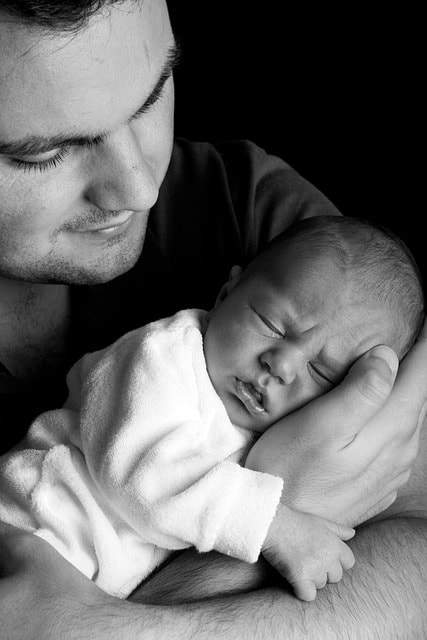What should you expect with a newborn infant in the first month? This guide covers physical characteristics, vital developmental milestones, and essential care tips to help you understand and support your baby’s early days.
Table of Contents
Key Takeaways
Newborns exhibit unique physical characteristics such as cone-shaped heads, varying hair types, and common skin conditions like vernix caseosa and milia, which normalize within the first weeks.
Developmental milestones in the first month include reflexive and sensory responses, coordination in movements, and establishing sleep patterns, which help gauge a baby’s growth and interaction with their environment.
Parental interaction, including responding to cries and engaging in sensory play and tummy time, is crucial for emotional and cognitive development, fostering secure attachment and early communication skills.
Understanding Newborn Physical Characteristics

Newborns come with a unique set of physical characteristics that may seem surprising at first. Getting to know these features can make you feel more comfortable as you familiarize yourself with your baby. Here are some common physical characteristics of newborns:
Wide shoulders, hips, and a head circumference of about 33-36 cm
Skin spots, rashes, or blotches, which are normal and usually temporary
Size at birth can be influenced by factors like the length of the pregnancy and whether the baby was born around their due date
Head and Hair
The journey through the birth canal can leave a newborn’s head temporarily cone-shaped due to the shifting and overlapping of skull bones. However, within a few days, their head usually becomes rounder. Newborns have two soft spots on their heads called fontanels, covered by a thick fibrous layer. These fontanels typically close by the age of two years,.
The hair of newborns can be quite varied, with some being born bald or with fine, downy hair called lanugo,. Interestingly, hair color and texture can change over time, with curly hair becoming straight or thick, dark hair becoming sparser and lighter.
Skin and Vernix Caseosa
At birth, a newborn’s skin is often grayish to dusky blue and covered with a white, cheesy substance known as vernix caseosa, which protects their skin in the womb,. Common skin conditions in the first few weeks include dry, peeling skin, especially on the hands and feet. You might also notice small white bumps called milia on their face, which typically disappear on their own.
Additionally, birthmarks and Mongolian spots are common and usually harmless.
Weight and Length
The average birth weight of a full-term newborn is about 3.4 kg, ranging from 2.7 to 4.6 kg. Similarly, their length typically falls between 35.6 and 50.8 cm. It’s normal for healthy term neonates to lose some weight initially but regain and surpass their birth weight within the first month.
This initial weight loss is generally followed by a steady weight gain, approximately 10-20 grams per kg per day after the first week.
Key Developmental Milestones in the First Month

The first month of life is packed with developmental milestones that mark your baby’s development. These milestones help gauge if a baby is developing as expected. From reflexes and movements to sensory responses and sleep patterns, these early achievements lay the foundation for future growth.
You will notice increasing coordination in their movements and a growing awareness of their surroundings.
Reflexes and Movements
Newborn babies, like many babies, exhibit a range of reflexes and involuntary movements that are crucial for their survival and development. In their first eight weeks, all physical activity is involuntary or reflexive. For instance, they often keep their hands in tight fists and display strong reflex movements.
Towards the end of the first month, you might observe jerky arm movements and attempts to move their hands towards their mouth. Lying on their stomach triggers an instinctual side-to-side head movement.
Sensory Responses
A newborn’s development greatly hinges on their sensory responses. They can focus on objects 8 to 12 inches away and show a preference for high-contrast patterns. Newborns enjoy looking at various things, whether it’s different rooms, people, or the outdoors. Their ability to locate sounds is particularly refined, helping them respond to potential dangers. You might notice them responding to sounds like snake hissing, adult angry voices, or even the cries of other infants. These responses are crucial for their survival and development.
Newborns exhibit their auditory response by blinking their eyes, orienting towards the sound source, accompanied by a decrease in heart rate. Observing these sensory responses is not only intriguing but also illuminates their early learning process and interaction with the surrounding world.
Sleep Patterns
Newborns are typically sleep-dominant, logging 14-17 hours within a 24-hour cycle, with some even reaching 18-19 hours. Sleep durations and cycles are often interrupted by the need to feed every few hours. As newborns age, their sleep patterns evolve, influenced by developmental milestones and various factors,.
It’s acceptable to let a baby sleep longer at night once they surpass their birth weight, usually within the first couple of weeks. Around 2-3 months of age, some babies begin to sleep for longer stretches, typically around 5-6 hours at a time. This is a positive development for both the baby and the parents.
Learn more, visit How to Set Good Sleep Patterns for Your Baby
Communication and Emotional Development
A newborn’s growth strongly depends on their communication and emotional development. From birth, babies communicate primarily through crying. This period is crucial for child development, particularly in terms of personality and forming the foundation of future relationships. As they transition into the toddler years, emotional development continues to play a significant role in a child’s overall growth.
Building trust and security in a baby significantly relies on parental interaction, including holding and conversing with the baby. Babies develop distinct relationships with their caregivers, and maternal sensitivity plays a significant role in fostering secure attachment.
Crying and Its Meanings
Crying is a newborn’s primary means of communication. Parents soon learn to recognize different types of cries that indicate:
hunger
discomfort
frustration
fatigue
loneliness
Understanding these cries enables many parents to respond appropriately to their baby’s needs, fostering a sense of security and trust.
Parental Interaction
Parental interaction is vital for a newborn’s emotional development. Here are some ways to promote healthy development:
Newborns’ hearing is fully mature, and they may turn towards familiar sounds and voices, especially those of their parents.
Gentle touching can help build a secure attachment.
Maintaining a calm emotional tone can create a soothing environment for the baby.
Responding to the baby’s cues shows them that their needs are being met.
By following these practices, you can help promote your newborn’s emotional development.
Feeding Your Newborn

Nutrition is a critical factor in a newborn’s care. Newborns might need to be fed every two to three hours, totaling eight to twelve feedings a day. Both breastfeeding and formula feeding are viable options, each with its benefits.
Eventually, weaning onto solid foods will be a part of your baby’s development.
Breastfeeding Benefits
Both the mother and the baby can reap numerous benefits from breastfeeding. Some of these benefits include:
Supporting a baby’s brain development and growth
Providing protection against common colds and serious conditions like asthma and leukemia
Establishing a strong bond between mother and baby, promoting emotional security
Breastfeeding is a natural and beneficial way to nourish and nurture your baby.
For mothers, breastfeeding can aid in recovery from childbirth and reduce postpartum bleeding. The hormones released during breastfeeding also offer protection against diabetes and certain cancers. These benefits make breastfeeding a highly recommended practice for the first six months of a baby’s life.
Formula Feeding
When breastfeeding is either not feasible or preferred, formula feeding serves as a dependable substitute. It provides a source of nutrition that meets the baby’s dietary needs,. However, formula feeding requires careful preparation and sterilization of bottles to ensure the baby’s health and safety.
Weaning Process
Weaning is the gradual process of transitioning from breast milk or formula to solid foods. This process typically begins around six months of age when the baby shows signs of developmental readiness, such as being able to sit up with support and showing interest in solid foods,.
Weaning should be gradual, starting with small amounts of solid foods while continuing breastfeeding or formula feeding,.
Health and Safety Considerations
Guaranteeing your newborn’s health and safety encompasses regular health care check-ups, timely immunizations, and the establishment of a secure sleeping environment. These measures, recommended by the World Health Organization, help monitor your baby’s development and protect them from preventable diseases and hazards.
Regular Check-ups
Routine pediatric appointments are crucial for monitoring developmental progress and early detection of potential concerns. These well-child visits assess a child’s growth and overall health, including physical and emotional aspects.
If breastfed, your newborn might need vitamin D drops to support bone health.
Immunizations
Adherence to the suggested immunization timetable is vital to ward off severe illnesses in newborns. Vaccinations protect against diseases like hepatitis B, polio, and measles. These are often administered during routine pediatric check-ups, ensuring your baby receives timely protection.
Safe Sleeping Environment
The establishment of a secure sleeping environment is key to diminishing the risk of Sudden Infant Death Syndrome (SIDS). Here are some guidelines to follow:
Always place your newborn on their back to sleep
Avoid placing soft objects or toys in the crib
Use a firm sleep surface
Keep the crib free of fluffy toys to prevent suffocation hazards
Breastfeeding has also been shown to reduce the risk of SIDS. These practices not only ensure the safety of your newborn but also provide peace of mind for parents, knowing they are taking steps to protect their baby’s well-being.
Enhancing Development Through Play and Interaction
Engaging in play and interaction with your newborn not only brings joy but is also indispensable for their progress. Play helps build:
Gross and fine motor skills
Strengthens the bond between baby and parent
Helps newborns learn about their world and how to interact with it, aiding brain development.
Engaging in activities like tummy time, sensory play, and talking to your newborn can significantly aid their overall development.
Tummy Time
Tummy time, a crucial activity for newborns, assists them in developing head control and fortifying their neck, shoulder, and arm muscles. This practice supports them in sitting up, crawling, and eventually walking. Regular tummy time can also prevent the development of flat spots on the back of a baby’s head.
Start with short 3- to 5-minute sessions and gradually increase to a total of 15 to 30 minutes daily by two months of age.
Sensory Play
Sensory play, instrumental in stimulating a newborn’s budding senses, aids in their environmental understanding. Providing objects with different textures, like soft toys or rattles, can engage your baby’s senses and promote their cognitive development.
This kind of play helps preschool age children understand their surroundings and contributes to their overall growth, as it does for other children.
Reading and Talking
Reading to your newborn and engaging in conversation fosters early language skills and lays the groundwork for communication. Engaging in language development activities, such as reading aloud and having “conversations” with your baby, helps foster growth in their communication skills from an early age.
Even simple actions like talking or making sounds and waiting for your baby’s response can teach them about conversational turns, an essential aspect of communication for a word toddler.
Summary
The first month of a newborn’s life is a whirlwind of changes and milestones. Understanding the physical characteristics of newborns, recognizing key developmental milestones, and knowing how to support their communication and emotional development are crucial for new parents. Proper feeding practices, regular health check-ups, and creating a safe environment further ensure your baby’s well-being.
By engaging in activities that promote development, such as tummy time, sensory play, and reading, you can significantly aid your newborn’s growth. These early months are foundational, and your attentive care will set the stage for a healthy and happy future. Embrace this precious time, knowing you are nurturing your baby in the best possible way.
Frequently Asked Questions
How much weight should my newborn gain in the first month?
Your newborn should regain their birth weight within the first month and gain around 10-20 grams per kilogram per day after the first week. This steady weight gain is a positive sign of development and growth.
How can I tell if my baby is hungry?
You can tell if your baby is hungry by looking for early signs such as moving hands to the mouth, sucking on fists, and lip smacking. These signals indicate that your baby may need to be fed.
What are the benefits of breastfeeding for my baby?
Breastfeeding offers crucial protection and support for your baby’s brain development, growth, and immune system. It also helps safeguard against common illnesses and serious conditions like asthma and leukemia.
How often should my newborn sleep?
Newborns typically sleep 14-17 hours over a 24-hour period, with some sleeping up to 18-19 hours, but their sleep is often interrupted by the need to feed every few hours. It’s important to ensure they get enough sleep to support their growth and development.
What is the purpose of tummy time?
Tummy time is important for newborns as it helps them develop strong neck, shoulder, and arm muscles, and supports motor skill development while preventing flat spots on their heads.









